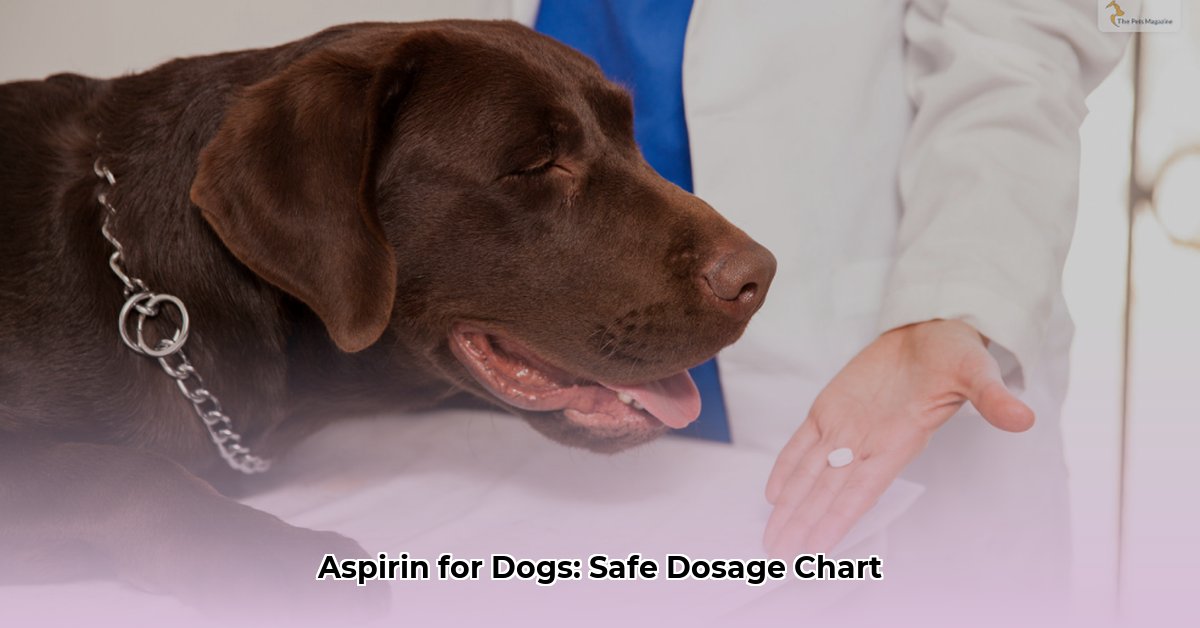Seeing your dog in pain is distressing, and you naturally want to help them feel better. While aspirin can be used for dogs in certain situations, it’s crucial to consult your veterinarian first. This guide provides essential information about giving aspirin to dogs, including when it’s appropriate, potential risks, and safer alternatives. Remember, this information is for educational purposes and does not replace professional veterinary advice.
Should You Give Your Dog Aspirin?
Before considering aspirin, it’s vital to understand that it’s not always safe for every dog. Certain factors significantly increase the risks, making veterinary consultation even more critical.
When to Contact Your Veterinarian Immediately
- Puppies and Senior Dogs: Younger and older dogs are more susceptible to aspirin’s adverse effects.
- Pre-existing Conditions: Dogs with kidney or liver problems, bleeding disorders, ulcers, or gastrointestinal issues should not receive aspirin without veterinary guidance.
- Pregnant or Nursing Dogs: Aspirin can have adverse effects on developing puppies and nursing mothers.
- Concurrent Medications: Aspirin can interact negatively with other medications. Inform your vet about any medications your dog is currently taking.
- Sudden or Severe Pain: Don’t try to manage sudden, severe pain, or any pain accompanied by other symptoms, with aspirin. Seek immediate veterinary care.
- Accidental Ingestion: If your dog accidentally consumes aspirin, contact your veterinarian or an animal poison control center right away.
Understanding Aspirin’s Effects on Dogs
Aspirin, a nonsteroidal anti-inflammatory drug (NSAID), reduces inflammation and pain. While it can provide temporary relief, it also carries potential risks, especially for dogs. These include stomach upset, ulcers, and internal bleeding. Some dogs are genetically more susceptible to these side effects.
Aspirin Dosage for Dogs: A Veterinarian’s Perspective
The following chart offers a general guideline for buffered aspirin dosage based on a dog’s weight. This is not a substitute for veterinary guidance. Your vet will consider your dog’s individual circumstances, health status, and other factors to determine the appropriate dosage and medication type.
| Dog’s Weight (lbs) | Estimated Aspirin Dosage (Buffered Aspirin Only) | Dog Breeds (Examples) |
|---|---|---|
| 0 – 5 | 25 to 50 mg (½ baby aspirin) | Pomeranian, Chihuahua, Toy Poodle |
| 5 – 10 | 50 to 100 mg (1 baby aspirin) | Boston Terrier, Pekingese, Shih Tzu |
| 10 – 20 | 100 to 200 mg (½ adult aspirin) | West Highland Terrier, Corgi, Jack Russell |
| 20 – 30 | 150 to 300 mg (½ – 1 adult aspirin) | Beagle, Cocker Spaniel, French Bulldog |
| 30 – 40 | 200 to 400 mg (1 adult aspirin) | Vizsla, Samoyed, Bulldog |
| 40 – 50 | 250 to 500 mg (1-1.5 adult aspirin) | Irish Setter, Airedale Terrier, Border Collie |
| 50 – 60 | 300 to 600 mg (1-2 adult aspirin) | Labrador, Golden Retriever, Siberian Husky |
| 60 – 70 | 350 to 700 mg (1-2 adult aspirin) | Chow Chow, American Staffordshire Terrier, Boxer |
| 70 – 80 | 400 to 800 mg (2 adult aspirin) | Cane Corso, Rottweiler, Doberman Pinscher |
| 80 – 90 | 450 to 900 mg (1.5-2.5 adult aspirin) | Bloodhound, German Shepherd, Bernese Mountain Dog |
| 90 – 100+ | 500 to 1000 mg (2-3 adult aspirin) | Great Dane, Saint Bernard, Mastiff |
Important Considerations:
- Buffered vs. Enteric-Coated: Buffered aspirin is generally preferred for dogs as it’s less likely to cause stomach irritation. Never use enteric-coated aspirin without express veterinary approval.
- Frequency: Aspirin is typically given every 12 hours, but this can vary. Always follow your veterinarian’s instructions.
- Duration: Do not administer aspirin for more than five days without veterinary supervision.
How to Administer Aspirin (If Directed by Your Vet)
Your veterinarian will provide detailed instructions. Here are some general tips if hiding medication is needed:
- Pill Pockets: Many dogs readily accept medication hidden in commercially available pill pockets.
- Food: Conceal the pill in a small amount of enticing, dog-safe food like cheese or a small amount of xylitol-free peanut butter.
Recognizing and Responding to Potential Problems
Even with the correct dosage, monitor your dog closely for potential side effects. Signs include:
- Vomiting (especially if it resembles coffee grounds)
- Changes in stool (dark, tarry stools)
- Loss of appetite
- Lethargy
- Increased thirst or urination
- Pale gums
Suspected Overdose: If you suspect an overdose, contact your veterinarian or an emergency animal hospital immediately. Symptoms can include:
- Rapid breathing
- Tremors
- Seizures
- Coma
Safer Alternatives to Aspirin for Dogs
Many safer and more effective pain management options exist for dogs. Your vet might suggest the following:
- Canine NSAIDs: Carprofen (Rimadyl), deracoxib (Deramaxx), and firocoxib (Previcox) are NSAIDs specifically formulated for dogs and are generally safer than aspirin.
- Other pain medications: Gabapentin, Tramadol.
- Complementary Therapies: Acupuncture, laser therapy, massage, and physical rehabilitation can help manage pain. Discuss these options with your vet.
- Supplements, and Alternative Treatments CBD Oil, turmeric, and joint supplements like glucosamine and chondroitin might be beneficial for certain dogs.
Conclusion
While aspirin can be used in dogs under specific circumstances and with veterinary guidance, it’s crucial to understand the potential risks. Prioritizing your dog’s safety by consulting your veterinarian before administering any medication is paramount. They can assess your dog’s individual needs and recommend the safest and most effective pain management strategy. Remember, preventative care and open communication with your vet are essential for ensuring your dog’s long-term health and well-being.
- Adult Bento Meal Ideas for Delicious, Easy, and Healthy Lunches - December 24, 2025
- Adult Bento Box Ideas for Delicious and Easy Lunches - December 23, 2025
- Healthy Bento Lunch Ideas for Adults to Enjoy Lunch Again - December 22, 2025










